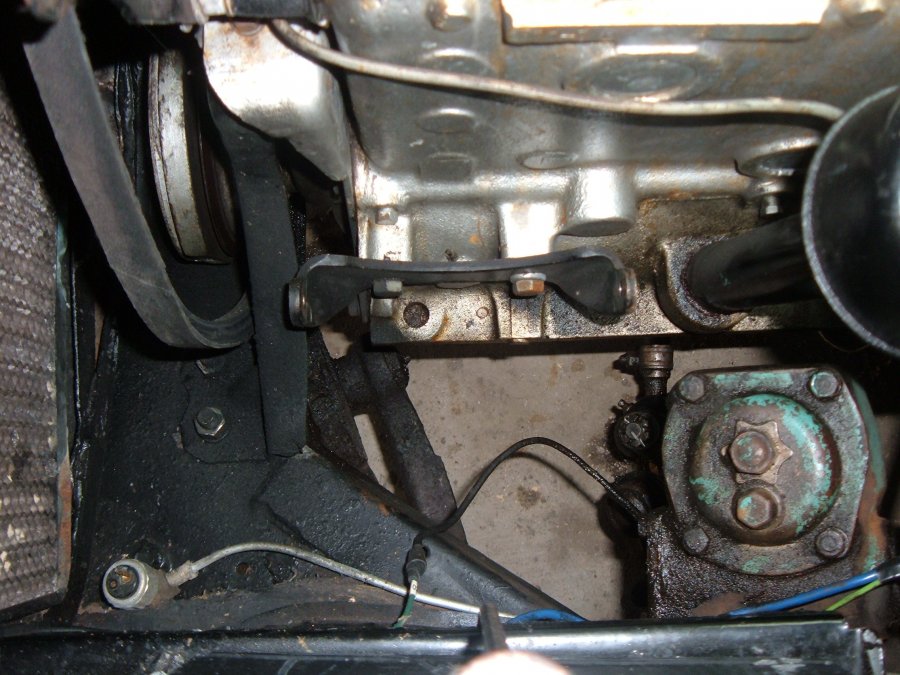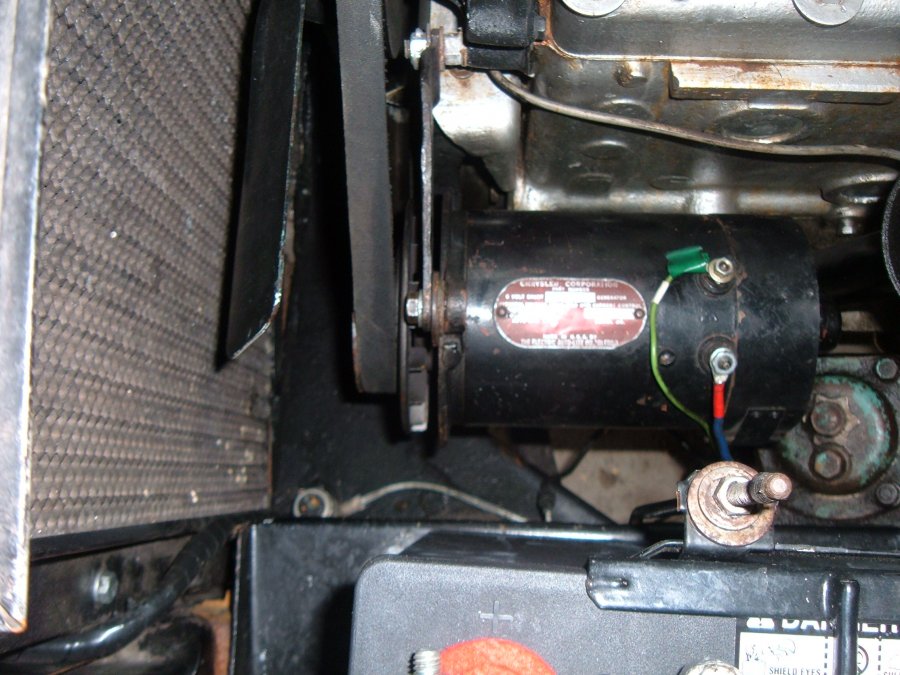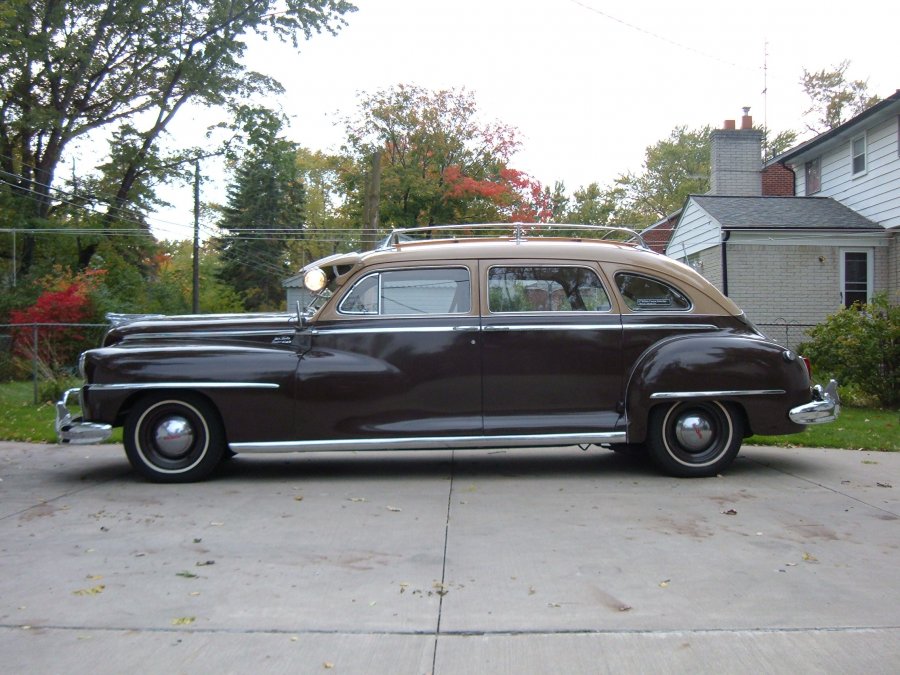-
Posts
2,471 -
Joined
-
Last visited
-
Days Won
25
Content Type
Links Directory
Profiles
Articles
Forums
Downloads
Store
Gallery
Blogs
Events
Everything posted by DonaldSmith
-
Is the oil pump still in? It has a gear that runs off the camshaft (Item 23 in the above diagram)..
-
I've got split bench seats in my DeSoto Suburban. You can get to the second seat from the front doors, and the third seat from the back doors The philips screw has a shoulder which acts as the outboard pivot for the seat back. Remove the seat cushion, and you will find a nut and washer on the end of the large philips screw. Remove the nut, and the screw should unscrew. The inboard pivot is a stub attached to the seat back that fits in a hole in a central bracket. In installing the seat back, have fun fitting the stub in the hole and lining up the philips screw. It gets easier with practice.
-
Double check that your distributor is not 180 degrees off. Been there, done that. The marks on the damper pulley don't tell you if Top Dead Center is at the end of the compression stroke or 180 degrees off. I've used the thumb method of determining if No. 1 (or No. 6) is at TDC of the compression stroke. Plugs out. Thumb over the plug hole. I can feel the compression stroke. Another way is to have an in-line spark indicator on the spark plug wire. I can see the plug getting its jolt as the damper marks are around TDC.
-
Some tire lug wrenches tend to be 3/4 inch or 19 mm, virtually interchangeable. 19 mm equals 0.74803 inch, just shy of 0.75 inch. I have a folding 4-way tire wrench, that has four sizes; if I remember, one size is noted as both 3/4 inch and 19 mm.
-
Since the transmission upshifts and downshifts, it's the semi-automatic. You mention a vacuum diaphragm. The 41 used a vacuum system to make the downshift. It sounds like you have the M4 transmission. Some of the guys can chip in. Also, get a shop manual to see how the transmission works, or is supposed to work. My '47 has the M5 transmisson, which uses a governor and solenoid to control oil pressure to make the downshift. Unintentional grounding of the downshift circuit would cause it to downshift unintentionally. Something similar is happening with your vacuum controls. (Additional information:) My transmission has reverse in the usual location, towards the driver and up, and the driving range is away and down, like third gear for a manual transmission. (The car takes off in third gear, courtesy of the fluid coupling, and upshifts to fourth gear.) There is a power range, away and up, like second gear in a manual transmission. (The car takes off in first gear, and upshifts to second gear; seldom used; called the "stump puller" gears.) There is no to-the-driver and down position, as for first gear of a manual transmission.
-
Point made; the fluid drive is not the transmission but the coupling. But Royal Duke must be talking about the semi-automatic transmission, with downshifts and a vacuum diaphragm, a la 1941... M4?
-
I kept my steering wheel and column when I added a power steering gearbox to my 47 DeSoto. Same considerations as for adding a rack and pinion. Support the steering column at the firewall, while keeping the shifting apparatus; find a way to maintain contact with the horn wire that runs from the steering wheel; shorten the steering column and add a spline and universal joints to run to the steering box or rack. At the top of the page, select "Downloads", then "Instructions, Manuals & Templates", then download "Power Steering", Chapters 1, 2 and 3, Steering Column Jacket, Horn Contact, and Steering Shaft Modifications. It was my trial-and-error way, maybe something you can adapt to your situation.
-
I've got belts from Grainger Industrial Supply. Estimate a length with rope or similar. Order a few different lengths. Sometimes they are in stock, or pick up the next day. Take back the ones that are too long or too short. No problem, if the belt is still clean, unbuggered, and back in its original sleeve.
-
The arm has to pivot as the generator is moved toward and away from the engine. So the bolt has to be loosened. This can allow a leak, as the bolt goes into the water jacket of the block. Short term, maybe no big deal. But it bothered me, so I substituted a stud that would not be loosened.
-
Haunted by the ancient archives - Once upon a time, I had the adjustment arm like so: I don't remember how far away the arm was from the generator boss when I swung them together. What's done is done. Do whatever works.
-
I might make a pinhole viewing device. Take a box, put a pinhole in one side, and let the image fall on the other side. Put a big hole in the top, for looking inside, without letting in too much stray light. The word "camera" means "room". Before there was film or glass plates that could be exposed and developed. the "camera scura", or "dark room", would provide an exact but inverted image of the world outside, on the far wall, or on a tablet or on transparent sheet. Artists could now get the perspective exact. The pinhole provided full depth of field but limited light. Lenses increased the brightness, but had to be focused. Multiple lenses had to be combined, to account for varying lengths of light waves, to avoid (technical words coming:) chromatic aberration. Now a miniature lens at the corner of an electronic tablet produces amazingly sharp images. 'mazing.
-
Maybe a fender brace was an optional delete item, depending on production vicissitudes, like hood braces. They put them in if they felt like it, if the line wasn't too rushed, and if the supply was not interrupted.
-
Now my basic beliefs are shattered. Maybe there is more than one way to install an adjustment arm. Maybe the slot is supposed to be at the bottom, and behind the generator boss. Nah, my way has the advantage that I was able to seal a stud and nut at the block, rather than having to loosen a bolt to free the arm, and the arm is free to pivot without loosening a bolt. To quote my mother-in-law: "' To each his own," said the lady as she kissed the cow."
-
Yep, Bingster's adjusting bracket is flipped. And the bolt at the generator screws into the generator. Washer(s) between the bracket and the generator. Here's the bracket with an extension for my alternator. Pretend the extension is not there. Slot is along the top. I have ground the curve from time to time, to clear whatever setup I had.
-
Here was my setup (I have an alternator now): Yes, getting the belt on the generator pulley may be a challenge. Try it with the belt off the water pump pulley, getting it on the generator pulley, and then working it over the water pump pulley flange. (I changed the bolt through the water pump into a stud, so that it could remained sealed when I messed with the adjustment arm. The arm is loose on the stud. I drilled through the nut keeping the arm on, and ran a cotter pin through the nut and the stud.)
-
My DeSoto Suburban looked a little high in the back, so I added 2-inch blocks. after: (Edit: substituted a better photo)
-
Cool! I need two of those for my 47 DeSoto. It looks like something I can make from flattening each end of a chunk of EMT in a vise. I used a turnbuckle to pull one of my fenders in line. I'll make one of these the right length and substitute it for the turnbuckle.
-
You only have the center brake light, if it is still stock. Check the bulb and ground, and maybe add a ground wire (Some people put double filament bulbs in the tail lights, t o have brake lights there also.) The hydraulic brake switch is notorious for failing. You could replace it when it goes bad, or substitute a mechanical brake switch.
-
Just one wire. Grounded to the engine. Internally regulated. Wire goes to ammeter.
-
Quick dinner. Alternator at generator bracket: A little surgery to the case,to accommodate the existing bracket. Adjustment arm:
-
I put a 6-volt positive ground alternator in My 47 DeSoto, years ago. A local auto electric place made it up for me, and installed a wide pulley to match what I had. The alternator has worked great. There was a brown wire running from a post on the starter solenoid to the "A" terminal of the generator. (Chrysler's way of keeping the starter from running when the generator is running.) I disconnected this brown wire from the "A" terminal and grounded it. You don't want or need the regulator. Keep it for looks, or get rid of it. I abandoned the green wire that ran between the "F" terminal of the generator and the "F" terminal of the regulator. A red wire ran from the "A" terminal of the generator to the "A" terminal of the regulator. Then a black wire ran from the "B" post of the regulator to the ammeter. I ran new wire from the alternator wire to the ammeter. You could connect the alternator wire to the red wire and connect the red wire to the black wire. I reused the generator bracket. More to follow. Dinner time.
-
jgreg53 wrote: "The instructions with the wires didn't say for me to trim the insulation from the wires so that the core wire was exposed before putting on the end clip. should I have done that?" Huh? Just checking; either "Did this." or "Duh! So that's the problem!": Expose the core wire by stripping back the insulation far enough that the core wire can be doubled back against the insulation and be in generous contact with the end clip.
-
I believe that the front doors for the 2-door sedan are identical with the front doors of the long wheelbase sedan. The tip-off, how the doors meet at the top. On my Suburban, the front door has a curve, so the rear door has to meet it. On the suicide door sedan, the tops of the doors are in line. Also for the 2-door sedan and the long-wheelbase sedan, the front door is 9 inches wider, for access to the back or middle seat. Coupe doors are wide, maybe the same width, but the glass frame slopes forward. I don't know if the town sedan gets away with the same front door as the suicide door sedan. But Mopar would if it could.
-
Did anyone explain a front end shop? "Front end" includes things like the front suspension, steering arms, springs, alignment, etc. In our neck of the woods, a firm may specialize in repairing such things, and would be a Front End Shop. So, someone in the Netherlands repairs such things, by whatever name. Now, rear end is another matter- differential, axle, springs, etc. That's one meaning. A lady went into an auto repair shop and complained, "There's a strange noise coming out of my rear end." The mechanic said, "We'll get it up on the hoist right away." .
-
This adding fuel prank was in Mechanix Illustrated or similar magazine, in the '50s, Gus' Garage, or something like that. upon the owner of a new car. First half, bragging about excellen tmilage. Only the pranksters back then, for the second half of the prank, actually removed gas from the tank.







